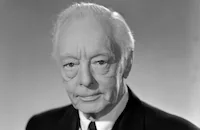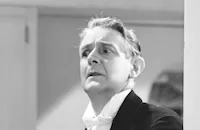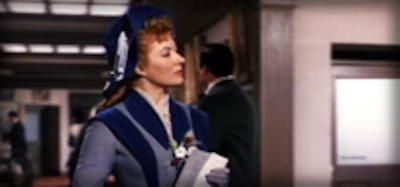That Forsyte Woman

Brief Synopsis
Cast & Crew
Compton Bennett
Errol Flynn
Greer Garson
Walter Pidgeon
Robert Young
Janet Leigh
Film Details
Technical Specs

Synopsis
On a foggy London night in 1887, Irene Forsyte, wife of the wealthy Soames Forsyte, rushes to a hospital to be at the side of Philip Bosinney, who has been run over by a speeding carriage. Philip dies from his injuries, and Irene tries to comfort his fiancée, June Forsyte, who angrily blames Irene for his death. June refuses to listen to Irene's explanation, but Young Jolyon Forsyte, Soames's cousin and June's father, understands her grief and recalls the time, seven years earlier, when Irene was first introduced to his snobbish family: On the night of Old Jolyon Forsyte's eightieth birthday celebration, his rigid nephew Soames announces that he intends to marry Irene, a piano teacher from a lower class. The Forsytes react with shock and displeasure at the announcement and all but shun Irene, but she later finds her sole family ally in Jolyon, an artist and the black sheep of the family. Jolyon empathizes with Irene's poor rapport with the family, as he has been ostracized from it and denied permission to visit his daughter. Irene soon realizes that her relationship with Soames is doomed, but when she tries to break off the engagement, Soames refuses to abide by her wishes and instead buys a large house for them. In time, Irene resigns herself to a loveless marriage with Soames, and the Forsyte family eventually comes to accept her. Irene also builds a friendship with June, who takes Irene with her as a chaperon on her date with her new beau, Philip Bossiney, a young, charismatic architect. By the time of Irene and Soames's second wedding anniversary, Irene and Philip have fallen in love, and Soames has become increasingly tortured by his marriage. In an attempt to improve their relationship, Soames buys a country property and hires Philip to design an elaborate house for them. Always insistent upon receiving value for money spent, Soames becomes increasingly annoyed with Philip's delays and extra expenditures over the next months. Meanwhile, although Irene has thwarted Philip's attempt to steal her away from Soames by telling him that she will not leave her husband, June soon suspects that Philip is in love with someone else. When June later tells Irene that she will kill herself if Philip has been unfaithful, Irene persuades Philip not to tell June that he is no longer in love with her. Philip promises this to Irene in exchange for her promise to meet him at his studio. Just prior to Philip and Irene's planned rendezvous, though, June arrives at the empty studio and finds a sketch of Irene with a romantic inscription by Philip. Devastated, June flees before Philip and Irene arrive, and then takes vengeance by sending a note to Soames about his wife's affair. After trying once again to end her affair with Philip, Irene returns home only to be met with the wrath of her husband. During their quarrel, when Irene confesses her love for Philip, Soames vows to drive Philip out of the city and out of his profession, then strikes his wife. Soames later summons Philip to his home to present him with a lawsuit, and when Philip tries to make a hasty departure, he is run over and killed by a speeding carriage. When Irene learns of the tragedy, she rushes to the hospital to see Philip. Jolyon concludes his recollection of the events leading up to Philip's death, and then invites Irene to live in Paris with him. Time passes, and when Irene, now married to Jolyon, sees the distraught Soames trying in vain to purchase a portrait of her in a gallery, she takes pity on him and persuades Jolyon to allow it to be sold to him, saying that they are so rich, while he is so poor.

Director

Compton Bennett
Cast

Errol Flynn

Greer Garson

Walter Pidgeon

Robert Young

Janet Leigh

Harry Davenport
Aubrey Mather
Gerald Oliver Smith
Lumsden Hare
Stanley Logan

Halliwell Hobbes
Matt Moore
Florence Auer

Phyllis Morris
Marjorie Eaton
Evelyn Beresford
Richard Lupino
Wilson Wood
Gabrielle Windsor
Renee Mercer
Nina Ross
Constance Cavendish
Charles Mcnaughton
Wallis Clark
James Aubrey
Isabel Randolph
Tim Hawkins
Olaf Hytten
Reginald Sheffield
Frank Baker
Jean Ransome
William Eddritt

Leonard Carey
Morgan Farley
John Sheffield
Herbert Evans

Billy Bevan
David Dunbar
Colin Kenny
Leland Hodgson
Rolfe Sedan
Andre Charlot
Lilian Bond
Blanche Franke
Jack Chefe
Olga Nina Borget
Albert Petit
Jimmy Hawkins
Gloria Gordon
Norman Rainey
Crew
Bob Barnes
Daniel B. Cathcart
Jack Dawn
Cedric Gibbons
James Gooch
Leon Gordon
Sydney Guilaroff
Henri Jaffa
Bronislau Kaper
Jan Lustig
Jack D. Moore
Walter Plunkett
Joseph Ruttenberg
Douglas Shearer
Frederick Y. Smith
Ivan Tors
Valles
James B. Williams
Edwin B. Willis
Arthur Wimperis

Photo Collections
Videos
Movie Clip




Trailer
Film Details
Technical Specs

Award Nominations
Best Costume Design
Articles
That Forsyte Woman
Flynn had been one of Warner Brothers' top stars for a dozen years, a swashbuckler, ladies' man and carouser both on and off screen. But his years of personal excess were beginning to take their toll. And critics and Flynn himself were growing tired of his dashing-rogue screen image. When Flynn was loaned out to MGM for That Forsyte Woman, he was expected to play Soames' bohemian cousin, or the passionate architect who falls in love with Irene. Instead, Flynn insisted on tackling the more complex Soames.
For MGM's grande dame Greer Garson, playing a corseted Victorian lady was no problem. But in real life, Garson was anything but grand. She was warm and merry, with a wicked sense of humor. Garson recalled her first meeting with Flynn: "We greeted each other warily...in an electric atmosphere of mutual apprehension, while gleeful columnists and set-siders waited breathlessly for the predicted clash between MGM's Nice Lady, and Warner Brothers' Bad Boy. It never came." A nervous Flynn had steeled himself for the meeting with several drinks. He shook hands with his co-star, then slapped Garson's bottom and said "Hiya Red!" Garson laughed, and from then on, the laughter never stopped. Both stars were pranksters, and delighted in practical joke one-upsmanship. In one scene, Garson had to pull a dress out of a closet. The cameras rolled, and when she opened the closet, there was Flynn, wearing nothing but a top hat. Garson got even when the two were doing a scene in a carriage. She set up an electric charge under Flynn's seat, and gave him a shock that sent him leaping into the air.
Cast as the senior member of the Forsyte family was veteran character actor Harry Davenport. That Forsyte Woman was his last film. He died in 1949 at age 83, after 77 years as an actor.
Critics' reaction to That Forsyte Woman was tepid, although many of them admired Flynn's portrayal. But most of them found the film stodgy and artificial, and were reduced to reviewing the gorgeousness of the sets and costumes. Like many of MGM's literary adaptations, That Forsyte Woman was a little too reverential to the original novel. But it does provide the opportunity to see a performance by Flynn that flexes those acting muscles that he had, but rarely used.
Director: Compton Bennett
Producer: Leon Gordon
Screenplay: Jan Lustig, Ivan Tors, James B. Williams, Arthur Wimperis, from the novel A Man of Property, by John Galsworthy
Cinematography: Joseph Ruttenberg
Editor: Fredrick Y. Smith
Costume Design: Walter Plunkett, Valles
Art Direction: Cedric Gibbons, Daniel B. Cathcart, set design by Edwin B. Willis, Jack D. Moore
Music: Bronislau Kaper
Principal Cast: Errol Flynn (Soames Forsyte), Greer Garson (Irene Forsyte), Walter Pidgeon (Young Jolyon Forsyte), Robert Young (Philip Bosinney), Janet Leigh (June Forsyte), Harry Davenport (Old Jolyon Forsyte), Stanley Logan (Swithin Forsyte), Lumsden Hare (Roger Forsyte).
C-113m. Closed captioning.
by Margarita Landazuri

That Forsyte Woman
Quotes
Trivia
C. Aubrey Smith was originally scheduled to play the part of Jolyon Forsyte, but the illness preceding his death prevented it.
Notes
The working title for this film was The Forsyte Saga. According to a pre-release news item in Time magazine, M-G-M decided to change the title of the film from The Forsyte Saga to That Forsyte Woman because a survey showed that many Americans did not know the meaning of the word "saga." The film was released in Britain as The Forsyte Saga. While onscreen credits indicate that the film was "based on Book 1 of The Forsyte Saga," the actual title of that book was The Man of Property. Galsworthy received the Nobel prize for literature in 1932, primarily for the novels of The Forsyte Saga. The author died in early 1938. A December 1934 Hollywood Reporter news item noted that RKO, which had optioned the screen rights to Galsworthy's story in April 1934, decided to abandon the production because the story was "too involved." M-G-M purchased the rights to The Forsyte Saga in May 1937, at which time a Hollywood Reporter news item noted that M-G-M was planning to adapt the saga into a series, and that Edward Chodorov was set to direct the first film. In June 1937, a Hollywood Reporter news item noted that the saga would be produced as a two-hour feature.
In October 1947, according to Hollywood Reporter, M-G-M producer Robert Lord was announced as the film's producer. Contemporary sources note that Errol Flynn was loaned to M-G-M from Warner Bros. in exchange for the release of William Powell, who was cast in Warner Bros.' Life With Father. According to a 1949 Cue news item, Flynn was first cast in the role of "Young Jolyon Forstye," but because he objected to the part, he was later assigned to play "Soames." Walter Plunkett and Valles' costume design received an Academy Award nomination. Greer Garson and Walter Pidgeon recreated their roles for a Lux Radio Theatre broadcast on November 5, 1951. In 1966, BBC-TV produced an internationally popular twenty-six-segment adaptation of The Forsyte Saga, directed by David Giles and James Cellan Jones, and starring Eric Porter, Kenneth More and Nyree Dawn Porter.

Miscellaneous Notes
Released in United States Fall November 11, 1949
Released in United States Fall November 11, 1949














